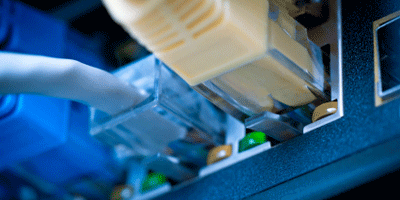Colorful Options for Quantum Dots
In a future world, where data is carried by quantum states of light, the “cable guy” will need an interferometer to fix the internet router. For now, researchers designing quantum networks have to tackle a more fundamental problem: how to integrate different components—single-photon emitters, detectors, and transmission lines—that don’t operate at the same frequency. In Physical Review Letters, two groups report a first measurement of how well the quantum states of light emitted by quantum dots are preserved when the light is converted to more useful frequencies.
Optically excited quantum dots—nanometer-scale collections of atoms which collectively support quantized electronic states—perform well as single-photon emitters. But the brightest, most efficient quantum dots emit visible or near-infrared light, while optical fibers are optimized for the mid-infrared. Also, quantum dots tend to have slightly different shapes and compositions, so that no two of them emit at the same frequency, complicating their use in some applications.
While tweaking the quantum dot can change the frequency of the emitted light, the groups instead use an approach that modifies the emitted photons themselves: they channel the single photons and an infrared laser through a nonlinear optical waveguide, which outputs light with a frequency that is the sum or difference of the two inputs. Serkan Ates and colleagues at NIST in Gaithersburg, Maryland, convert two single photon sources operating at different near-infrared frequencies to the same higher frequency yellow light, making the photons identical in a wavelength region where some silicon detectors operate most efficiently. Independently, Sebastian Zaske, at Saarland University in Germany, and co-workers convert red photons to 1.313 microns, which lies in the so-called telecom band of fiber optics where transmission losses are low.
Both groups determine a conversion efficiency of greater than 30%, in line with what previous researchers have achieved for single photon frequency conversion; but, they also establish, for the first time, new tools for manipulating the frequencies of quantum dot single photon sources that doesn’t destroy quantum coherence, paving the way for the use of these frequency converters in future quantum information processing systems. – Jessica Thomas





